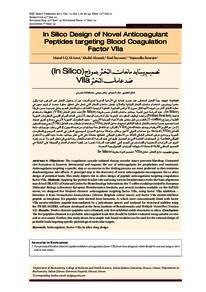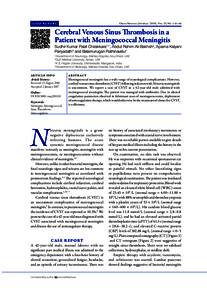Document
In Silico Design of Novel Anticoagulant Peptides targeting Blood Coagulation Factor VIIa.
Contributors
Other titles
تصميم بيبتايد مانعات التخثر بنموذج (In Silico) VIIa ضد عامل التخثر
Publisher
College of Medicine, Sultan Qaboos University.
Gregorian
2011-02
Language
English
English abstract
Objectives: The coagulation cascade initiated during vascular injury prevents bleeding. Unwanted
clot formation is however detrimental and requires the use of anticoagulants for prophylaxis and treatment.
Anticoagulants targeting a specific step or an enzyme in the clotting process are most preferred as they minimise
disadvantageous side-effects. A principal step in the discovery of novel anticoagulants encompasses the in silico
design of potential leads. This study depicts the in silico design of peptide anticoagulants targeting coagulation
factor VIIa. Methods: Applying the proline bracket rule and using various bioinformatics tools: the basic alignment
search tool (BLAST) of National Center for Biotechnology Information; the T-coffee module provided by European
Molecular Biology Laboratory-European Bioinformatics Institute, and several modules available on the ExPASy
server, we designed five bivalent chimeric anticoagulants targeting factor VIIa, using factor VIIa inhibitors –
hemextin A from Hemachatus haemachatus (African Ringhals cobra) venom and factor VIIa exosite-inhibitor
peptide as templates. Six peptides were derived from hemextin A, which were concomitantly fused with factor
VIIa exosite-inhibitor peptide intermediated by a polyalanine spacer, and analysed for structural stability using
the SWISS-MODEL software developed at the Swiss Institute of Bioinformatics and WebLab ViewerPro (Version
4.2). Results: Twelve chimeric peptides were obtained; only five exhibited stable structures in silico. Conclusion: The five peptides obtained are probable anticoagulant leads that should be further evaluated using suitable in vitro
and in vivo assays. Further, this study shows how simple web-based modules can be used for the rational design of
probable leads targeting specific physiological molecular targets.
Description
12 pages
Member of
Resource URL
Citation
Al-Amriyah, Manal S. Q., Al-Rasadi, Khalid, Bayoumi, Riad, & Banerjee, Yajnavalka (2011). In Silico Design of Novel Anticoagulant Peptides targeting Blood Coagulation Factor VIIa. Sultan Qaboos University Medical Journal, 11 (1), 83–94.
Arabic abstract
الهدف: يبدأ التخثر المتعاقب عند حدوث إصابة في الأوعية الدموية لمنع النزف، غير أن حصول التخثر غير المرغوب فيه يكون مضرا ويستوجب استخدام مانعات التخثر للوقاية والعلاج. نفضل مانعات التخثر التي تعمل على تعطيل خطوة محددة أو إنزيم معين في عملية التخثر أكثر من غيرها لأنها تقلل حدوث الأعراض الجانبية. الخطوة الرئيسية لاكتشاف مانع التختر الجديد يشمل تصميما حسب طريقة In Silico) . هذه الدراسة تبين أهمية بيبتايد مانعات التختر حسب طريقة (In Silico) ضد عامل التختر (VIIa). الطريقة باستخدام قاعدة (Proline bracket) وأيضا توظيف المعلومات الحيوية مثل أداة بحث الرصف الأساسي العائد للمركز القومي للمعلومات الحيوية التقنية ونموذج (coffee 1) المقدم من قبل مختبر علم الأحياء الجزيئية الأوربي - معهد المعلومات الحيوية الأوربي ونماذج أخرى عديدة، قمنا بتصميم خمسة مانعات للتخثر ثنائية التكافؤ تستهدف عامل التختر (VIIa)، باستخدام مثبطات ضد العامل (Vlla) وهي هيماكسيتين (1) من سم الكوبرا الأفريقية وبيبتايد مثبط للعامل (VIIa) كقوالب. تم اشتقاق ستة بيبتايدات من هيماكسيتين (أ) التي ربطت مع بيبتايد مثبط للعامل (VIIa) المتداخلة مع مساحات للبولي ألانين، وحللت بواسطة برنامج النموذج السويسري المطور في المعهد السويسري للمعلومات الحيوية وبرنامج عرض المختبر الشبكي للتأكد من الاستقرار الهيكلي النتائج حصلنا على اثني عشر بيبتايد، خمسة منها أظهرت الاستقرار الهيكلي. الخلاصة: إن البيبتايدات الخمسة التي تم الحصول عليها في هذه الدراسة كمانعات التخثر ربما تؤدي إلى تخثر الدم، ولا بد من إجراء المزيد من الدراسات المختبرية والقياسات في الجسم الحي. أعطت هذه الدراسية تصورا عن كيفية استخدام النماذج البسيطة على الشبكة في التصميم المنطقي للأدلة المحتملة لاستهداف الجزئيات الفسيولوجية المحددة.
Category
Journal articles



